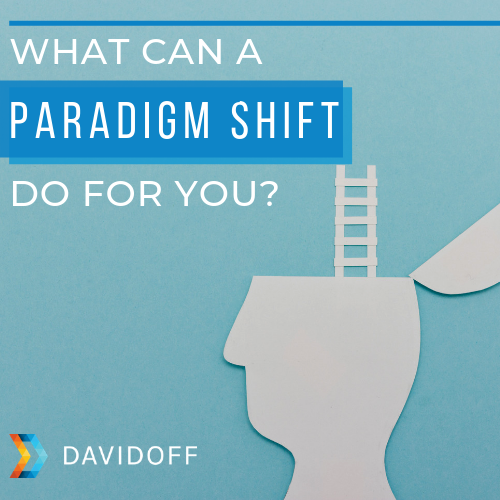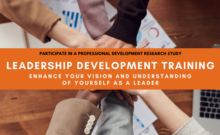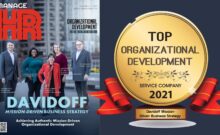Many organizations can benefit from a transformative paradigm shift, whether they realize it or not.
Thomas Kuhn first described the concept of a “paradigm shift” in his 1962 book The Structure of Scientific Revolutions. He was talking about how established scientific theories of the past became replaced by revolutionary new ones as new, conflicting evidence became available—such as evidence that the sun, not the earth, was our universe’s center.
But paradigm shifts apply very well to organizations too. Think of an organizational paradigm as the broad set of norms, values, and practices in place that guide behavior and decision-making. Like longstanding scientific theories, well-established paradigms may no longer fit with the organization’s current needs or those of its customers, beneficiaries, or environment, rendering it less capable of accomplishing its mission.
So it may be time for a paradigm shift.
Our work with wide-ranging organizations highlights the benefits of engaging in needed paradigm shifts:
- New understanding of the mission and/or identification of a new, more dynamic mission
- Better understanding of how to achieve the mission
- More involved, effective people, including leaders, employees, and board members
- Better reputation with beneficiaries, partners, and peer organizations
- Greater innovation and creativity
As an example, we recently helped the nonprofit News Literacy Project (NLP) engage in critical paradigm shifts. The organization was founded by Pulitzer Prize-winning journalist Alan Miller to help teach high-school and middle-school students to discern authentic journalism from the increasing number of “fake news” sources.
NLP had gained positive attention and funding for its mission, but when Davidoff partnered with the organization to lead its first strategic planning process, we saw a challenge. Specifically, NLP simultaneously benefited from founder Miller’s reputation, commitment, and resources, but also was potentially relying excessively on the founder, which might limit collective growth and development.
Working together with NLP leadership, we committed to help the organization undertake a broad paradigm shift from “founder-driven” to “organization-led,” to enable everyone within NLP to be more fully part of its mission and growth to the next level.
Undertaking a paradigm shift of any kind means more than just trying to move the organization from some Point A to Point B. It means understanding why you need to take a truly revolutionary leap forward, and formulating the right plan to do so. So the organization has to be ready to ask tough questions such as “What is our full potential—and are we reaching it?” and “How can we maximize our relevance to stakeholders?”
We helped NLP ask—and answer—questions like those to illuminate the challenges of a founder-driven organization. In NLP’s case, these included a less engaged board, some concern among funders about NLP’s reliance on Miller, and wariness on the part of some high-potential job candidates regarding joining an organization where the founder was so influential and hands-on, which might have meant limited growth opportunity for others.
Identifying the need for a paradigm shift is only the first step. Here are several best practices we’ve helped our clients carry out in undertaking these transitions, again with illustrative examples from NLP.
Identify and articulate the present state. Start with a thorough self-assessment. We provide an online assessment of Mission-Challenged versus Mission-Driven organizational elements that can be a useful starting point. Remember: it’s important to talk to people inside and outside your organization to understand potential challenges and improvement opportunities, whether funders, partners, or consultants. Also remember that a paradigm shift isn’t the answer to every organizational challenge. Sometimes it’s about smaller fixes. So be honest about what’s needed. NLP, for example, recognized the benefits of multiple paradigm shifts.
Formulate—and name—the ideal state. Where would you like to be? Use what you learn from the assessment to articulate the ideal states you’d like to get to. Typically this will involve more than one shift. NLP wanted to move from founder-driven to organization-led, but also wanted to shift from grassroots programs/services to digital, scalable delivery, to drive greater impact. Other shifts include moving from an exclusive to inclusive culture, and from a reactive to proactive approach to carrying out the mission.
Get everyone involved. In developing tactics to enact the paradigm shift, make it as inclusive as possible, rather than defaulting to leadership only by executives and the board. This will promote a greater sense of inclusion and ownership.
Pull on the Mission-Driven thread. The theme of remaining Mission-Driven should be a constant throughout any transition. That gives people confidence and courage to move away from the status quo. NLP, for example, never wavered from its Mission-Driven approach to helping youth identify authentic information sources. Indeed, the willingness to self-examine that paradigm shifts require is a hallmark of every Mission-Driven organization.
Be empathetic. Change is threatening for most organizations and the people within them. So paradigm shifts, as large-scale changes, can promote existential anxiety among your constituents. Acknowledge this reality and reinterpret fear as a natural, needed, healthy part of the process. That will help people channel anxiety into positive action toward enacting the paradigm shift.
The paradigm shift journey is well worth it, as NLP discovered firsthand. The organization’s board became much more engaged, for example, galvanized by leadership’s new, more collective focus. Founder Alan Miller felt affirmed by the process, too, and focused on serving as NLP’s thought leader, spokesperson, and connection to funders, hiring a COO and sharing operational responsibilities more with fellow leaders. The organization doubled its staff size over the subsequent year, and expanded its reach into more schools. That year, NLP had its largest funding ever, including its most sizable grant.
NLP is far from alone. So many organizations can benefit from thinking about a paradigm shift, as we’ve seen over and over in our work. It starts with the simplest thing: an open mind. We hope this blog helps you consider the potential need for a paradigm shift, as part of ongoing efforts to be a Mission-Driven organization.





